Differential Expression of Serum MicroRNAs Supports CD4+ T Cell Differentiation into Th2/Th17 Cells in Severe Equine Asthma
Abstract
1. Introduction
2. Materials and Methods
2.1. Samples
2.2. Data Pre-Processing and Initial Quality Control
2.3. Novel miRNA Identification
2.4. Identification of a Read Count Threshold to Select Relevant miRNAs
2.5. Differential Expression Analysis
2.6. mRNA-miRNA Interaction
2.7. Functional Enrichment of DEmiR Target Genes
2.8. Code
3. Results
3.1. Small RNA Sequencing and Data Quality Control
3.2. Novel miRNA Identification
3.3. Threshold Read Count Value Determination by KS-Test
3.4. MiRNA Expression Profile
3.5. Hemolysis Effect on miRNA Expression Profile
3.6. Asthma Related miRNAs
3.7. mRNA-miRNA Interactions
3.8. Functional Enrichment of DEmiR Target Genes
4. Discussion
4.1. Hemolysis Effect on miRNA Expression Profile
4.2. Asthma Related miRNAs
4.3. Biological Implications: Th2/Th17/Th1 Immune Response
4.4. Biological Implications: Asthma and Cell Cycle Regulators
4.5. Known Biological Implications of the Remaining DEmiRs
4.6. mRNA-miRNA Interactions
4.7. Functional Enrichment of DEmiR Target Genes and Network Analysis
5. Conclusions
Supplementary Materials
Acknowledgments
Author Contributions
Conflicts of Interest
Appendix A
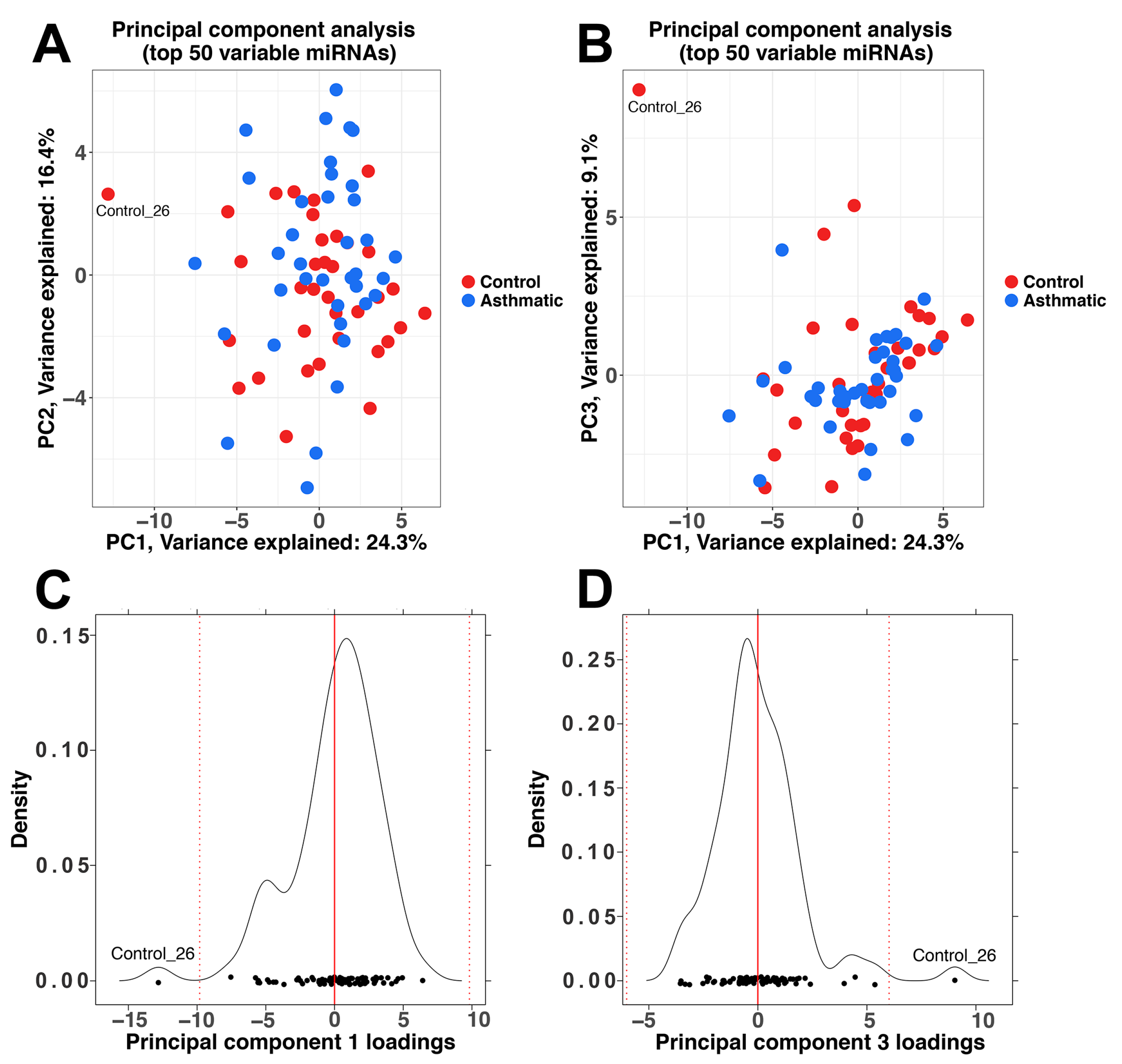

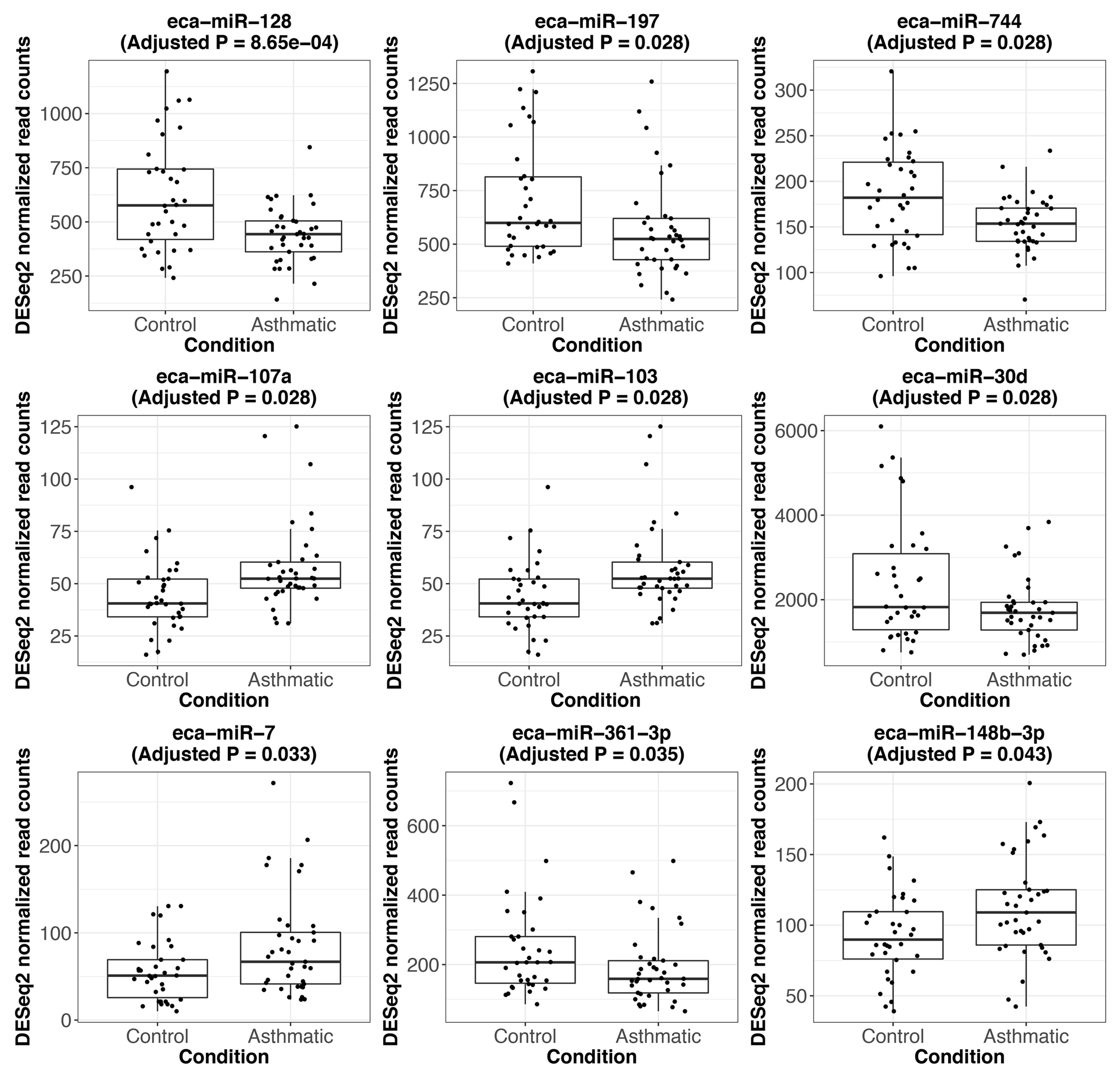

References
- Ansotegui, I.; Arruda, L.K.P.; Badellino, H.A.; Baena-Cagnani, C.E.; Bahna, S.L.; Baldacci, S.; Bel, E.; Bieber, T.R.M.; Bindslev-Jensen, C.; Blaiss, M.S.; et al. White Book on Allergy: Update 2013; Pawankar, R., Holgate, S.T., Canonica, G.W., Lockey, R.F., Blaiss, M.S., Eds.; World Allergy Organization (WAO): Milwaukee, WI, USA, 2013; ISBN 9780615929156. [Google Scholar]
- To, T.; Simatovic, J.; Zhu, J.; Feldman, L.; Dell, S.D.; Lougheed, M.D.; Licskai, C.; Gershon, A. Asthma deaths in a large provincial health system: A 10-year population-based study. Ann. Am. Thorac. Soc. 2014, 11, 1210–1217. [Google Scholar] [CrossRef] [PubMed]
- Gullach, A.J.; Risgaard, B.; Lynge, T.H.; Jabbari, R.; Glinge, C.; Haunsø, S.; Backer, V.; Winkel, B.G.; Tfelt-Hansen, J. Sudden death in young persons with uncontrolled asthma—A nationwide cohort study in Denmark. BMC Pulm. Med. 2015, 15, 35. [Google Scholar] [CrossRef] [PubMed]
- Torgerson, D.G.; Capurso, D.; Mathias, R.A.; Graves, P.E.; Hernandez, R.D.; Beaty, T.H.; Bleecker, E.R.; Raby, B.A.; Meyers, D.A.; Barnes, K.C.; et al. Resequencing candidate genes implicates rare variants in asthma susceptibility. Am. J. Hum. Genet. 2012, 90, 273–281. [Google Scholar] [CrossRef] [PubMed]
- Vercelli, D. Discovering susceptibility genes for asthma and allergy. Nat. Rev. Immunol. 2008, 8, 169–182. [Google Scholar] [CrossRef] [PubMed]
- Braun-Fahrlander, C.; Riedler, J.; Herz, U.; Eder, W.; Waser, M.; Grize, L.; Maisch, S.; Carr, D.; Gerlach, F.; Bufe, A.; et al. Environmental exposure to endotoxin and its relation to asthma in school-age children. N. Engl. J. Med. 2002, 347, 869–877. [Google Scholar] [CrossRef] [PubMed]
- Eisenbarth, S.C.; Piggott, D.A.; Huleatt, J.W.; Visintin, I.; Herrick, C.A.; Bottomly, K. Lipopolysaccharide-enhanced, toll-like receptor 4-dependent T helper cell type 2 responses to inhaled antigen. J. Exp. Med. 2002, 196, 1645–1651. [Google Scholar] [CrossRef] [PubMed]
- March, M.E.; Sleiman, P.M.; Hakonarson, H. Genetic polymorphisms and associated susceptibility to asthma. Int. J. Gen. Med. 2013, 6, 253–265. [Google Scholar] [CrossRef] [PubMed]
- Wenzel, S.E. Asthma: Defining of the persistent adult phenotypes. Lancet 2006, 368, 804–813. [Google Scholar] [CrossRef]
- Ober, C.; Hoffjan, S. Asthma genetics 2006: The long and winding road to gene discovery. Genes Immun. 2006, 7, 95–100. [Google Scholar] [CrossRef] [PubMed]
- Moffatt, M.F.; Kabesch, M.; Liang, L.; Dixon, A.L.; Strachan, D.; Heath, S.; Depner, M.; von Berg, A.; Bufe, A.; Rietschel, E.; et al. Genetic variants regulating ORMDL3 expression contribute to the risk of childhood asthma. Nature 2007, 448, 470–473. [Google Scholar] [CrossRef] [PubMed]
- Couëtil, L.L.; Cardwell, J.M.; Gerber, V.; Lavoie, J.P.; Léguillette, R.; Richard, E.A. Inflammatory Airway Disease of Horses-Revised Consensus Statement. J. Vet. Intern. Med. 2016, 30, 503–515. [Google Scholar] [CrossRef] [PubMed]
- Bullone, M.; Lavoie, J.-P.P. Asthma “of horses and men”–How can equine heaves help us better understand human asthma immunopathology and its functional consequences? Mol. Immunol. 2015, 66, 97–105. [Google Scholar] [CrossRef] [PubMed]
- Herszberg, B.; Ramos-Barbón, D.; Tamaoka, M.; Martin, J.G.; Lavoie, J.P. Heaves, an asthma-like equine disease, involves airway smooth muscle remodeling. J. Allergy Clin. Immunol. 2006, 118, 382–388. [Google Scholar] [CrossRef] [PubMed]
- Pirie, R.S.; Dixon, P.M.; McGorum, B.C. Evaluation of nebulised hay dust suspensions (HDS) for the diagnosis and investigation of heaves. 3: Effect of fractionation of HDS. Equine Vet. J. 2002, 34, 343–347. [Google Scholar] [CrossRef] [PubMed]
- Lanz, S.; Gerber, V.; Marti, E.; Rettmer, H.; Klukowska-Rötzler, J.; Gottstein, B.; Matthews, J.B.; Pirie, S.; Hamza, E. Effect of hay dust extract and cyathostomin antigen stimulation on cytokine expression by PBMC in horses with recurrent airway obstruction. Vet. Immunol. Immunopathol. 2013, 155, 229–237. [Google Scholar] [CrossRef] [PubMed]
- Gerber, V.; Baleri, D.; Klukowska-Rötzler, J.; Swinburne, J.E.; Dolf, G. Mixed inheritance of equine recurrent airway obstruction. J. Vet. Intern. Med. 2009, 23, 626–630. [Google Scholar] [CrossRef] [PubMed]
- Swinburne, J.E.; Bogle, H.; Klukowska-Rötzler, J.; Drögemüller, M.; Leeb, T.; Temperton, E.; Dolf, G.; Gerber, V. A whole-genome scan for recurrent airway obstruction in Warmblood sport horses indicates two positional candidate regions. Mamm. Genome 2009, 20, 504–515. [Google Scholar] [CrossRef] [PubMed]
- Marti, E.; Gerber, H.; Essich, G.; Oulehla, J.; Lazary, S. The genetic basis of equine allergic diseases. 1. Chronic hypersensitivity bronchitis. Equine Vet J 1991, 23, 457–460. [Google Scholar] [CrossRef] [PubMed]
- Chen, X.; Ba, Y.; Ma, L.; Cai, X.; Yin, Y.; Wang, K.; Guo, J.; Zhang, Y.; Chen, J.; Guo, X.; et al. Characterization of microRNAs in serum: A novel class of biomarkers for diagnosis of cancer and other diseases. Cell Res. 2008, 18, 997–1006. [Google Scholar] [CrossRef] [PubMed]
- Hashimoto, Y.; Akiyama, Y.; Yuasa, Y. Multiple-to-Multiple Relationships between MicroRNAs and Target Genes in Gastric Cancer. PLoS ONE 2013, 8, e62589. [Google Scholar] [CrossRef] [PubMed]
- Li, J.; Zhang, Y.; Li, D.; Liu, Y.; Chu, D.; Jiang, X.; Hou, D.; Zen, K.; Zhang, C.Y. Small non-coding RNAs transfer through mammalian placenta and directly regulate fetal gene expression. Protein Cell 2015, 6, 391–396. [Google Scholar] [CrossRef] [PubMed]
- Liang, H.; Gong, F.; Zhang, S.; Zhang, C.-Y.Y.; Zen, K.; Chen, X. The origin, function, and diagnostic potential of extracellular microRNAs in human body fluids. Wiley Interdiscip. Rev. RNA 2014, 5, 285–300. [Google Scholar] [CrossRef] [PubMed]
- Eissa, N.T. The exosome in lung diseases: Message in a bottle. J. Allergy Clin. Immunol. 2015, 131, 904–905. [Google Scholar] [CrossRef] [PubMed]
- Simpson, L.J.; Patel, S.; Bhakta, N.R.; Choy, D.F.; Brightbill, H.D.; Ren, X.; Wang, Y.; Pua, H.H.; Baumjohann, D.; Montoya, M.M.; et al. A microRNA upregulated in asthma airway T cells promotes TH2 cytokine production. Nat. Immunol. 2014, 15, 1162–1170. [Google Scholar] [CrossRef] [PubMed]
- Sethi, A.; Kulkarni, N.; Sonar, S.; Lal, G. Role of miRNAs in CD4 T cell plasticity during inflammation and tolerance. Front. Genet. 2013, 4, 8. [Google Scholar] [CrossRef] [PubMed]
- Okoye, I.S.; Czieso, S.; Ktistaki, E.; Roderick, K.; Coomes, S.M.; Pelly, V.S.; Kannan, Y.; Perez-Lloret, J.; Zhao, J.L.; Baltimore, D.; et al. Transcriptomics identified a critical role for Th2 cell-intrinsic miR-155 in mediating allergy and antihelminth immunity. Proc. Natl. Acad. Sci. USA 2014, 111, E3081–E3090. [Google Scholar] [CrossRef] [PubMed]
- Kim, M.C.; Lee, S.W.; Ryu, D.Y.; Cui, F.J.; Bhak, J.; Kim, Y. Identification and Characterization of microRNAs in normal equine tissues by next generation sequencing. PLoS ONE 2014, 9, e93662. [Google Scholar] [CrossRef] [PubMed]
- Pacholewska, A.; Mach, N.; Vaiman, A.; Schibler, L.; Barrey, E.; Gerber, V. Novel equine tissue miRNAs and breed-related miRNA expressed in serum. BMC Genom. 2016, 17, 831. [Google Scholar] [CrossRef] [PubMed]
- Buza, T.; Arick, M.; Wang, H.; Peterson, D.G. Computational prediction of disease microRNAs in domestic animals. BMC Res. Notes 2014, 7, 403. [Google Scholar] [CrossRef] [PubMed]
- Van der Kolk, J.H.; Pacholewska, A.; Gerber, V. The role of microRNAs in equine medicine: A review. Vet. Q. 2015, 35, 88–96. [Google Scholar] [CrossRef] [PubMed]
- Kirschner, M.B.; Edelman, J.J.B.; Kao, S.C.H.; Vallely, M.P.; Van Zandwijk, N.; Reid, G. The impact of hemolysis on cell-free microRNA biomarkers. Front. Genet. 2013, 4, 94. [Google Scholar] [CrossRef] [PubMed]
- Pacholewska, A.; Jagannathan, V.; Drögemüller, M.; Klukowska-Rötzler, J.; Lanz, S.; Hamza, E.; Dermitzakis, E.T.; Marti, E.; Leeb, T.; Gerber, V. Impaired Cell Cycle Regulation in a Natural Equine Model of Asthma. PLoS ONE 2015, 10, e0136103. [Google Scholar] [CrossRef] [PubMed]
- Ramseyer, A.; Gaillard, C.; Burger, D.; Straub, R.; Jost, U.; Boog, C.; Marti, E.; Gerber, V. Effects of genetic and environmental factors on chronic lower airway disease in horses. J. Vet. Intern. Med. 2007, 21, 149–156. [Google Scholar] [CrossRef] [PubMed]
- Laumen, E.; Doherr, M.G.; Gerber, V. Relationship of horse owner assessed respiratory signs index to characteristics of recurrent airway obstruction in two Warmblood families. Equine Vet. J. 2010, 42, 142–148. [Google Scholar] [CrossRef] [PubMed]
- Bosshard, S.; Gerber, V. Evaluation of coughing and nasal discharge as early indicators for an increased risk to develop equine recurrent airway obstruction (RAO). J. Vet. Intern. Med. 2014, 28, 618–623. [Google Scholar] [CrossRef] [PubMed]
- Pacholewska, A.; Drögemüller, M.; Klukowska-rötzler, J.; Lanz, S.; Hamza, E.; Dermitzakis, E.T.; Marti, E.; Gerber, V.; Leeb, T.; Jagannathan, V. The transcriptome of equine peripheral blood mononuclear cells. PLoS ONE 2015, 10, e0122011. [Google Scholar] [CrossRef] [PubMed]
- Unger, L.; Fouché, N.; Leeb, T.; Gerber, V.; Pacholewska, A. Optimized Method for Extracting Circulating Small RNAs from Long—Term Stored Equine Samples. Acta Vet. Scand. 2016, 58, 44. [Google Scholar] [CrossRef] [PubMed]
- Kirschner, M.B.; Kao, S.C.; Edelman, J.J.; Armstrong, N.J.; Vallely, M.P.; van Zandwijk, N.; Reid, G. Haemolysis during sample preparation alters microRNA content of plasma. PLoS ONE 2011, 6, e24145. [Google Scholar] [CrossRef] [PubMed]
- Andrews, S. FastQC—A Quality Control Tool for High Throughput Sequence Data. 2010. Available online: https://www.bioinformatics.babraham.ac.uk/projects/fastqc/ (accessed on 11 October 2017).
- Martin, M. Cutadapt removes adapter sequences from high-throughput sequencing reads. EMBnet J. 2011, 17, 10. [Google Scholar] [CrossRef]
- European Nucleotide Archive. Available online: https://www.ebi.ac.uk/ena/data/view/PRJEB20494 (accessed on 24 April 2017).
- Wade, C.M.; Giulotto, E.; Sigurdsson, S.; Zoli, M.; Gnerre, S.; Imsland, F.; Lear, T.L.; Adelson, D.L.; Bailey, E.; Bellone, R.R.; et al. Genome Sequence, Comparative Analysis, and Population Genetics of the Domestic Horse. Science 2009, 326, 865–867. [Google Scholar] [CrossRef] [PubMed]
- Friedländer, M.R.; Mackowiak, S.D.; Li, N.; Chen, W.; Rajewsky, N.; Friedla, M.R.; Rajewsky, N. MiRDeep2 accurately identifies known and hundreds of novel microRNA genes in seven animal clades. Nucleic Acids Res. 2012, 40, 37–52. [Google Scholar] [CrossRef] [PubMed]
- Friedländer, M.R.; Chen, W.; Adamidi, C.; Maaskola, J.; Einspanier, R.; Knespel, S.; Rajewsky, N. Discovering microRNAs from deep sequencing data using miRDeep. Nat. Biotechnol. 2008, 26, 407–415. [Google Scholar] [CrossRef]
- Langmead, B.; Trapnell, C.; Pop, M.; Salzberg, S. Ultrafast and memory-efficient alignment of short DNA sequences to the human genome. Genome Biol. 2009, 10, R25. [Google Scholar] [CrossRef] [PubMed]
- Griffiths-Jones, S.; Grocock, R.J.; van Dongen, S.; Bateman, A.; Enright, A.J. miRBase: microRNA sequences, targets and gene nomenclature. Nucleic Acids Res. 2006, 34, D140–D144. [Google Scholar] [CrossRef] [PubMed]
- Quinlan, A.R.; Hall, I.M. BEDTools: A flexible suite of utilities for comparing genomic features. Bioinformatics 2010, 26, 841–842. [Google Scholar] [CrossRef] [PubMed]
- Koh, W.; Sheng, C.T.; Tan, B.; Lee, Q.Y.; Kuznetsov, V.; Kiang, L.S.; Tanavde, V. Analysis of deep sequencing microRNA expression profile from human embryonic stem cells derived mesenchymal stem cells reveals possible role of let-7 microRNA family in downstream targeting of hepatic nuclear factor 4 alpha. BMC Genom. 2010, 11, S6. [Google Scholar] [CrossRef] [PubMed]
- Kraft, M.F. GitHub. Available online: https://github.com/MatthiasKraft/Serum_miRNA_GENES (accessed on 15 September 2017).
- Love, M.I.; Huber, W.; Anders, S. Moderated estimation of fold change and dispersion for RNA-seq data with DESeq2. Genome Biol. 2014, 15, 550. [Google Scholar] [CrossRef] [PubMed]
- Robinson, M.D.; McCarthy, D.J.; Smyth, G.K. edgeR: A Bioconductor package for differential expression analysis of digital gene expression data. Bioinformatics 2010, 26, 139–140. [Google Scholar] [CrossRef] [PubMed]
- Anders, S.; McCarthy, D.J.; Chen, Y.; Okoniewski, M.; Smyth, G.K.; Huber, W.; Robinson, M.D. Count-based differential expression analysis of RNA sequencing data using R and Bioconductor. Nat. Protoc. 2013, 8, 1765–1786. [Google Scholar] [CrossRef] [PubMed]
- Lewis, B.P.; Burge, C.B.; Bartel, D.P. Conserved seed pairing, often flanked by adenosines, indicates that thousands of human genes are microRNA targets. Cell 2005, 120, 15–20. [Google Scholar] [CrossRef] [PubMed]
- Kinsella, R.J.; Kähäri, A.; Haider, S.; Zamora, J.; Proctor, G.; Spudich, G.; Almeida-King, J.; Staines, D.; Derwent, P.; Kerhornou, A.; et al. Ensembl BioMarts: A hub for data retrieval across taxonomic space. Database 2011, 2011. [Google Scholar] [CrossRef] [PubMed]
- Ashburner, M.; Ball, C.A.; Blake, J.A.; Botstein, D.; Butler, H.; Cherry, J.M.; Davis, A.P.; Dolinski, K.; Dwight, S.S.; Eppig, J.T.; et al. Gene ontology: Tool for the unification of biology. The Gene Ontology Consortium. Nat. Genet. 2000, 25, 25–29. [Google Scholar] [CrossRef] [PubMed]
- Nogales-Cadenas, R.; Carmona-Saez, P.; Vazquez, M.; Vicente, C.; Yang, X.; Tirado, F.; Carazo, J.M.; Pascual-Montano, A. GeneCodis: Interpreting gene lists through enrichment analysis and integration of diverse biological information. Nucleic Acids Res. 2009, 37, W317–W322. [Google Scholar] [CrossRef] [PubMed]
- Tabas-Madrid, D.; Nogales-Cadenas, R.; Pascual-Montano, A. GeneCodis3: A non-redundant and modular enrichment analysis tool for functional genomics. Nucleic Acids Res. 2012, 40, W478–W483. [Google Scholar] [CrossRef] [PubMed]
- Carmona-Saez, P.; Chagoyen, M.; Tirado, F.; Carazo, J.M.; Pascual-Montano, A. GENECODIS: A web-based tool for finding significant concurrent annotations in gene lists. Genome Biol. 2007, 8, R3. [Google Scholar] [CrossRef] [PubMed]
- Vlachos, I.S.; Paraskevopoulou, M.D.; Karagkouni, D.; Georgakilas, G.; Vergoulis, T.; Kanellos, I.; Anastasopoulos, I.L.; Maniou, S.; Karathanou, K.; Kalfakakou, D.; et al. DIANA-TarBase v7.0: Indexing more than half a million experimentally supported miRNA:mRNA interactions. Nucleic Acids Res. 2015, 43, D153–D159. [Google Scholar] [CrossRef] [PubMed]
- Li, H.; Durbin, R. Fast and accurate short read alignment with Burrows-Wheeler transform. Bioinformatics 2009, 25, 1754–1760. [Google Scholar] [CrossRef] [PubMed]
- Langmead, B.; Salzberg, S.L. Fast gapped-read alignment with Bowtie 2. Nat. Methods 2013, 9, 357–359. [Google Scholar] [CrossRef] [PubMed]
- Nawrocki, E.P.; Burge, S.W.; Bateman, A.; Daub, J.; Eberhardt, R.Y.; Eddy, S.R.; Floden, E.W.; Gardner, P.P.; Jones, T.A.; Tate, J.; et al. Rfam 12.0: Updates to the RNA families database. Nucleic Acids Res. 2015, 43, D130–D137. [Google Scholar] [CrossRef] [PubMed]
- Mueller, R.S.; Janda, J.; Jensen-Jarolim, E.; Rhyner, C.; Marti, E. Allergens in veterinary medicine. Allergy Eur. J. Allergy Clin. Immunol. 2016, 71, 27–35. [Google Scholar] [CrossRef] [PubMed]
- Lee, S.; Hwang, S.; Yu, H.J.; Oh, D.; Choi, Y.J.; Kim, M.C.; Kim, Y.; Ryu, D.Y. Expression of microRNAs in horse plasma and their characteristic nucleotide composition. PLoS ONE 2016, 11, e0146374. [Google Scholar] [CrossRef] [PubMed]
- Pritchard, C.C.; Kroh, E.; Wood, B.; Arroyo, J.D.; Dougherty, K.J.; Miyaji, M.M.; Tait, J.F.; Tewari, M. Blood cell origin of circulating microRNAs: A cautionary note for cancer biomarker studies. Cancer Prev. Res. 2012, 5, 492–497. [Google Scholar] [CrossRef] [PubMed]
- Wang, L.S.; Li, L.; Li, L.; Chu, S.; Shiang, K.D.; Li, M.; Sun, H.Y.; Xu, J.; Xiao, F.J.; Sun, G.; et al. MicroRNA-486 regulates normal erythropoiesis and enhances growth and modulates drug response in CML progenitors. Blood 2015, 125, 1302–1313. [Google Scholar] [CrossRef] [PubMed]
- Shaham, L.; Vendramini, E.; Ge, Y.; Goren, Y.; Birger, Y.; Tijssen, M.R.; McNulty, M.; Geron, I.; Schwartzman, O.; Goldberg, L.; et al. MicroRNA-486-5p is an erythroid oncomiR of the myeloid leukemias of down syndrome. Blood 2015, 125, 1292–1301. [Google Scholar] [CrossRef] [PubMed]
- Rüegger, S.; Großhans, H. MicroRNA turnover: When, how, and why. Trends Biochem. Sci. 2012, 37, 436–446. [Google Scholar] [CrossRef] [PubMed]
- Hauser, B.; Zhao, Y.; Pang, X.; Ling, Z.; Myers, E.; Wang, P.; Califano, J.; Gu, X. Functions of MiRNA-128 on the Regulation of Head and Neck Squamous Cell Carcinoma Growth and Apoptosis. PLoS ONE 2015, 10, e0116321. [Google Scholar] [CrossRef] [PubMed]
- Hu, J.; Cheng, Y.; Li, Y.; Jin, Z.; Pan, Y.; Liu, G.; Fu, S.; Zhang, Y.; Feng, K.; Feng, Y. microRNA-128 plays a critical role in human non-small cell lung cancer tumourigenesis, angiogenesis and lymphangiogenesis by directly targeting vascular endothelial growth factor-C. Eur. J. Cancer 2014, 50, 2336–2350. [Google Scholar] [CrossRef] [PubMed]
- Sun, J.; Liao, K.; Wu, X.; Huang, J.; Zhang, S.; Lu, X. Serum microRNA-128 as a biomarker for diagnosis of glioma. Int. J. Clin. Exp. Med. 2015, 8, 456–463. [Google Scholar] [PubMed]
- Adlakha, Y.K.; Saini, N. miR-128 exerts pro-apoptotic effect in a p53 transcription-dependent and -independent manner via PUMA-Bak axis. Cell Death Dis. 2013, 4, e542. [Google Scholar] [CrossRef] [PubMed]
- Adlakha, Y.K.; Khanna, S.; Singh, R.; Singh, V.P.; Agrawal, A.; Saini, N. Pro-apoptotic miRNA-128-2 modulates ABCA1, ABCG1 and RXR[alpha] expression and cholesterol homeostasis. Cell Death Dis. 2013, 4, e780. [Google Scholar] [CrossRef] [PubMed]
- Bartner, L.R.; Robinson, N.E.; Kiupel, M.; Tesfaigzi, Y. Persistent mucus accumulation: A consequence of delayed bronchial mucous cell apoptosis in RAO-affected horses? Am. J. Physiol. Lung Cell. Mol. Physiol. 2006, 291, L602–L609. [Google Scholar] [CrossRef] [PubMed]
- Moran, G.; Buechner-Maxwell, V.A.; Folch, H.; Henriquez, C.; Galecio, J.S.; Perez, B.; Carrasco, C.; Barria, M. Increased apoptosis of CD4 and CD8 T lymphocytes in the airways of horses with recurrent airway obstruction. Vet. Res. Commun. 2011, 35, 447–456. [Google Scholar] [CrossRef] [PubMed]
- Niedzwiedz, A.; Jaworski, Z.; Tykalowski, B.; Smialek, M. Neutrophil and macrophage apoptosis in bronchoalveolar lavage fluid from healthy horses and horses with recurrent airway obstruction (RAO). BMC Vet. Res. 2014, 10, 29. [Google Scholar] [CrossRef] [PubMed]
- Martinez-Nunez, R.T.; Bondanese, V.P.; Louafi, F.; Francisco-Garcia, A.S.; Rupani, H.; Bedke, N.; Holgate, S.; Howarth, P.H.; Davies, D.E.; Sanchez-Elsner, T. A microRNA network dysregulated in asthma controls IL-6 production in bronchial epithelial cells. PLoS ONE 2014, 9, e111659. [Google Scholar] [CrossRef] [PubMed]
- Rincon, M.; Irvin, C.G. Role of IL-6 in asthma and other inflammatory pulmonary diseases. Int. J. Biol. Sci. 2012, 8, 1281–1290. [Google Scholar] [CrossRef] [PubMed]
- Ordoñez, C.L.; Shaughnessy, T.E.; Matthay, M.A.; Fahy, J.V. Increased neutrophil numbers and IL-8 levels in airway secretions in acute severe asthma: Clinical and biologic significance. Am. J. Respir. Crit. Care Med. 2000, 161, 1185–1190. [Google Scholar] [CrossRef] [PubMed]
- Ainsworth, D.M.; Grönig, G.; Matychak, M.B.; Young, J.; Wagner, B.; Erb, H.N.; Antczak, D.F. Recurrent airway obstruction (RAO) in horses is characterized by IFNG and IL-8 production in bronchoalveolar lavage cells. Vet. Immunol. Immunopathol. 2003, 96, 83–91. [Google Scholar] [CrossRef]
- Berndt, A.; Derksen, F.J.; Venta, P.J.; Karmaus, W.; Ewart, S.; Robinson, N.E. Expression of toll-like receptor 2 mRNA in bronchial epithelial cells is not induced in RAO-affected horses. Equine Vet. J. 2009, 41, 76–81. [Google Scholar] [CrossRef] [PubMed]
- Ainsworth, D.M.; Wagner, B.; Franchini, M.; Grünig, G.; Erb, H.N.; Tan, J.Y. Time-dependent alterations in gene expression of interleukin-8 in the bronchial epithelium of horses with recurrent airway obstruction. Am. J. Vet. Res. 2006, 67, 669–677. [Google Scholar] [CrossRef] [PubMed]
- Chu, D.K.; Al-Garawi, A.; Llop-Guevara, A.; Pillai, R.A.; Radford, K.; Shen, P.; Walker, T.D.; Goncharova, S.; Calhoun, W.J.; Nair, P.; et al. Therapeutic potential of anti-IL-6 therapies for granulocytic airway inflammation in asthma. Allergy Asthma Clin. Immunol. 2015, 11, 14. [Google Scholar] [CrossRef] [PubMed]
- Smolen, J.S.; Maini, R.N. Interleukin-6: A new therapeutic target. Arthritis Res. Ther. 2006, 8 (Suppl. 2), S5. [Google Scholar] [CrossRef] [PubMed][Green Version]
- Martin, J.; Jenkins, R.H.; Bennagi, R.; Krupa, A.; Phillips, A.O.; Bowen, T.; Fraser, D.J. Post-transcriptional regulation of transforming growth factor beta-1 by microRNA-744. PLoS ONE 2011, 6, e25044. [Google Scholar] [CrossRef] [PubMed]
- Debrue, M.; Hamilton, E.; Joubert, P.; Lajoie-Kadoch, S.; Lavoie, J.P. Chronic exacerbation of equine heaves is associated with an increased expression of interleukin-17 mRNA in bronchoalveolar lavage cells. Vet. Immunol. Immunopathol. 2005, 105, 25–31. [Google Scholar] [CrossRef] [PubMed]
- Newcomb, D.C.; Peebles, R.S. Th17-mediated inflammation in asthma. Curr. Opin. Immunol. 2013, 25, 755–760. [Google Scholar] [CrossRef] [PubMed]
- Wang, H.; Su, X.; Yang, M.; Chen, T.; Hou, J.; Li, N.; Cao, X. Reciprocal control of miR-197 and IL-6/STAT3 pathway reveals miR-197 as potential therapeutic target for hepatocellular carcinoma. Oncoimmunology 2015, 4, e1031440. [Google Scholar] [CrossRef] [PubMed]
- Yang, X.O.; Panopoulos, A.D.; Nurieva, R.; Seon, H.C.; Wang, D.; Watowich, S.S.; Dong, C. STAT3 regulates cytokine-mediated generation of inflammatory helper T cells. J. Biol. Chem. 2007, 282, 9358–9363. [Google Scholar] [CrossRef] [PubMed]
- Chalmin, F.; Mignot, G.; Bruchard, M.; Chevriaux, A.; Végran, F.; Hichami, A.; Ladoire, S.; Derangère, V.; Vincent, J.; Masson, D.; et al. Stat3 and Gfi-1 Transcription Factors Control Th17 Cell Immunosuppressive Activity via the Regulation of Ectonucleotidase Expression. Immunity 2012, 36, 362–373. [Google Scholar] [CrossRef] [PubMed]
- Takagi, R.; Higashi, T.; Hashimoto, K.; Nakano, K.; Mizuno, Y.; Okazaki, Y.; Matsushita, S. B cell chemoattractant CXCL13 is preferentially expressed by human Th17 cell clones. J. Immunol. 2008, 181, 186–189. [Google Scholar] [CrossRef] [PubMed]
- Eddens, T.; Elsegeiny, W.; Garcia-Hernadez, M.L.; Castillo, P.; Trevejo-Nunez, G.; Serody, K.; Campfield, B.T.; Khader, S.A.; Chen, K.; Rangel-Moreno, J.; et al. Pneumocystis-Driven Inducible Bronchus-Associated Lymphoid Tissue Formation Requires Th2 and Th17 Immunity. Cell Rep. 2017, 18, 3078–3090. [Google Scholar] [CrossRef] [PubMed]
- Elliot, J.G.; Jensen, C.M.; Mutavdzic, S.; Lamb, J.P.; Carroll, N.G.; James, A.L. Aggregations of lymphoid cells in the airways of nonsmokers, smokers, and subjects with asthma. Am. J. Respir. Crit. Care Med. 2004, 169, 712–718. [Google Scholar] [CrossRef] [PubMed]
- Damsker, J.M.; Hansen, A.M.; Caspi, R.R. Th1 and Th17 cells: Adversaries and collaborators. Ann. N. Y. Acad. Sci. 2010, 1183, 211–221. [Google Scholar] [CrossRef] [PubMed]
- Irvin, C.; Zafar, I.; Good, J.; Rollins, D.; Christianson, C.; Gorska, M.M.; Martin, R.J.; Alam, R. Increased frequency of dual-positive TH2/TH17 cells in bronchoalveolar lavage fluid characterizes a population of patients with severe asthma. J. Allergy Clin. Immunol. 2014, 134, 1175–1186. [Google Scholar] [CrossRef] [PubMed]
- Takahashi, Y.; Forrest, A.R.R.; Maeno, E.; Hashimoto, T.; Daub, C.O.; Yasuda, J. MiR-107 and MiR-185 can induce cell cycle arrest in human non small cell lung cancer cell lines. PLoS ONE 2009, 4, e6677. [Google Scholar] [CrossRef] [PubMed]
- Xia, W.; Ni, J.; Zhuang, J.; Qian, L.; Wang, P.; Wang, J. MiR-103 regulates hepatocellular carcinoma growth by targeting AKAP12. Int. J. Biochem. Cell Biol. 2016, 71, 1–11. [Google Scholar] [CrossRef] [PubMed]
- Badalà, F.; Nouri-mahdavi, K.; Raoof, D.A. Expansion of an atypical NK cell subset in mouse models of SLE. Computer (Long. Beach. Calif). 2008, 144, 724–732. [Google Scholar] [CrossRef]
- Ballabio, E.; Mitchell, T.; van Kester, M.S.; Taylor, S.; Dunlop, H.M.; Tosi, I.; Vermeer, M.H.; Tramonti, D.; Saunders, N.J.; Boultwood, J.; et al. MicroRNA expression in Sézary syndrome: Identification, function, and diagnostic potential. Blood 2013, 116, 1105–1113. [Google Scholar] [CrossRef] [PubMed]
- Akbas, F.; Coskunpinar, E.; Yildiz, P. Analysis of serum micro-rnas as potential biomarker in chronic obstructive. Exp. Lung Res. 2012, 38, 286–294. [Google Scholar] [CrossRef]
- Hong, C.F.; Lin, S.Y.; Chou, Y.T.; Wu, C.W. MicroRNA-7 compromises p53 protein-dependent apoptosis by controlling the expression of the chromatin remodeling factor SMARCD1. J. Biol. Chem. 2016, 291, 1877–1889. [Google Scholar] [CrossRef] [PubMed]
- Porto, I.O.P.; Mendes-Junior, C.T.; Felício, L.P.; Georg, R.C.; Moreau, P.; Donadi, E.A.; Chies, J.A.B.; Castelli, E.C. MicroRNAs targeting the immunomodulatory HLA-G gene: A new survey searching for microRNAs with potential to regulate HLA-G. Mol. Immunol. 2015, 65, 230–241. [Google Scholar] [CrossRef] [PubMed]
- Tan, Z.; Randall, G.; Fan, J.; Camoretti-Mercado, B.; Brockman-Schneider, R.; Pan, L.; Solway, J.; Gern, J.E.; Lemanske, R.F.; Nicolae, D.; et al. Allele-Specific Targeting of microRNAs to HLA-G and Risk of Asthma (PII:S0002-9297(07)63059-6). Am. J. Hum. Genet. 2008, 82, 251. [Google Scholar] [CrossRef]
- Enomoto, Y.; Takagi, R.; Naito, Y.; Kiniwa, T.; Tanaka, Y.; Hamada-Tsutsumi, S.; Kawano, M.; Matsushita, S.; Ochiya, T.; Miyajima, A. Identification of the novel 3′ UTR sequences of human IL-21 mRNA as potential targets of miRNAs. Sci. Rep. 2017, 7, 7780. [Google Scholar] [CrossRef] [PubMed]
- Sun, Y.; Pan, J.; Mao, S.; Jin, J. IL-17/miR-192/IL-17Rs regulatory feedback loop facilitates multiple myeloma progression. PLoS ONE 2014, 9, e114647. [Google Scholar] [CrossRef] [PubMed]
- McGeachie, M.J.; Davis, J.S.; Kho, A.T.; Dahlin, A.; Sordillo, J.E.; Sun, M.; Lu, Q.; Weiss, S.T.; Tantisira, K.G. Asthma remission: Predicting future airways responsiveness using an miRNA network. J. Allergy Clin. Immunol. 2017, 140, 598–600. [Google Scholar] [CrossRef] [PubMed]
- Pereira-Leal, J.B.; Seabra, M.C. Evolution of the Rab family of small GTP-binding proteins. J. Mol. Biol. 2001, 313, 889–901. [Google Scholar] [CrossRef] [PubMed]
- Seto, S.; Tsujimura, K.; Koide, Y. Rab GTPases Regulating Phagosome Maturation Are Differentially Recruited to Mycobacterial Phagosomes. Traffic 2011, 12, 407–420. [Google Scholar] [CrossRef] [PubMed]
- Ding, L.; Abebe, T.; Beyene, J.; Wilke, R.A.; Goldberg, A.; Woo, J.G.; Martin, L.J.; Rothenberg, M.E.; Rao, M.; Hershey, G.K.K.; et al. Rank-based genome-wide analysis reveals the association of Ryanodine receptor-2 gene variants with childhood asthma among human populations. Hum. Genom. 2013, 7, 16. [Google Scholar] [CrossRef] [PubMed]
- Probert, K.; Miller, S.; Kheirallah, A.K.; Hall, I.P. Developmental genetics of the COPD lung. COPD Res. Pract. 2015, 1, 10. [Google Scholar] [CrossRef]
- Tang, W.; Kowgier, M.; Loth, D.W.; Soler Artigas, M.; Joubert, B.R.; Hodge, E.; Gharib, S.A.; Smith, A.V.; Ruczinski, I.; Gudnason, V.; et al. Large-Scale Genome-Wide Association Studies and Meta-Analyses of Longitudinal Change in Adult Lung Function. PLoS ONE 2014, 9, e100776. [Google Scholar] [CrossRef] [PubMed]
- Szabo, S.J.; Kim, S.T.; Costa, G.L.; Zhang, X.; Fathman, C.G.; Glimcher, L.H. A novel transcription factor, T-bet, directs Th1 lineage commitment. Cell 2000, 100, 655–669. [Google Scholar] [CrossRef]
- Mullen, A.C.; Hutchins, A.S.; High, F.A.; Lee, H.W.; Sykes, K.J.; Chodosh, L.A.; Reiner, S.L. Hlx is induced by and genetically interacts with T-bet to promote heritable T(H)1 gene induction. Nat. Immunol. 2002, 3, 652–658. [Google Scholar] [CrossRef] [PubMed]
- Casaca, V.I.; Illi, S.; Suttner, K.; Schleich, I.; Ballenberger, N.; Klucker, E.; Turan, E.; von Mutius, E.; Kabesch, M.; Schaub, B. TBX21 and HLX1 polymorphisms influence cytokine secretion at birth. PLoS ONE 2012, 7, e31069. [Google Scholar] [CrossRef] [PubMed]
- Murphy, T.M.; Wong, C.C.Y.; Arseneault, L.; Burrage, J.; Macdonald, R.; Hannon, E.; Fisher, H.L.; Ambler, A.; Moffitt, T.E.; Caspi, A.; et al. Methylomic markers of persistent childhood asthma: A longitudinal study of asthma-discordant monozygotic twins. Clin. Epigenet. 2015, 7, 130. [Google Scholar] [CrossRef] [PubMed]
- Suttner, K.; Rosenstiel, P.; Depner, M.; Schedel, M.; Pinto, L.A.; Ruether, A.; Adamski, J.; Klopp, N.; Illig, T.; Vogelberg, C.; et al. TBX21 gene variants increase childhood asthma risk in combination with HLX1 variants. J. Allergy Clin. Immunol. 2009, 123, 1062–1068. [Google Scholar] [CrossRef] [PubMed]
- Suttner, K.; Ruoss, I.; Rosenstiel, P.; Depner, M.; Pinto, L.A.; Schedel, M.; Adamski, J.; Illig, T.; Schreiber, S.; von Mutius, E.; Kabesch, M. HLX1 gene variants influence the development of childhood asthma. J. Allergy Clin. Immunol. 2009, 123, 82–88. [Google Scholar] [CrossRef] [PubMed]
- Wenzel, S.E. Asthma phenotypes: The evolution from clinical to molecular approaches. Nat. Med. 2012, 18, 716–725. [Google Scholar] [CrossRef] [PubMed]
- Raundhal, M.; Morse, C.; Khare, A.; Oriss, T.B.; Milosevic, J.; Trudeau, J.; Huff, R.; Pilewski, J.; Holguin, F.; Kolls, J.; et al. High IFN-γ and low SLPI mark severe asthma in mice and humans. J. Clin. Investig. 2015, 125, 3037–3050. [Google Scholar] [CrossRef] [PubMed]
- Hackett, T.-L. Epithelial–mesenchymal transition in the pathophysiology of airway remodelling in asthma. Curr. Opin. Allergy Clin. Immunol. 2012, 12, 53–59. [Google Scholar] [CrossRef] [PubMed]
- Ijaz, T.; Pazdrak, K.; Kalita, M.; Konig, R.; Choudhary, S.; Tian, B.; Boldogh, I.; Brasier, A.R. Systems biology approaches to understanding Epithelial Mesenchymal Transition (EMT) in mucosal remodeling and signaling in asthma. World Allergy Organ. J. 2014, 7, 13. [Google Scholar] [CrossRef] [PubMed]
- Han, J.M.; Patterson, S.J.; Levings, M.K. The Role of the PI3K Signaling Pathway in CD4+ T Cell Differentiation and Function. Front. Immunol. 2012, 3, 245. [Google Scholar] [CrossRef] [PubMed]
- Wang, J.; Li, F.; Yang, M.; Wu, J.; Zhao, J.; Gong, W.; Liu, W.; Bi, W.; Dong, L. FIZZ1 promotes airway remodeling through the PI3K/Akt signaling pathway in asthma. Exp. Ther. Med. 2014, 7, 1265–1270. [Google Scholar] [CrossRef] [PubMed]
- Sheller, J.R.; Polosukhin, V.V.; Mitchell, D.; Cheng, D.-S.; Peebles, R.S., Jr.; Blackwell, T.S. NF-kB Induction in Airway Epithelium Increases Lung Inflammation in Allergen Challenged Mice. Exp. Lung Res. 2009, 35, 883–895. [Google Scholar] [CrossRef] [PubMed]
- Graham, J.A.; Fray, M.; de Haseth, S.; Lee, K.M.; Lian, M.M.; Chase, C.M.; Madsen, J.C.; Markmann, J.; Benichou, G.; Colvin, R.B.; et al. Suppressive Regulatory T Cell Activity Is Potentiated by Glycogen Synthase Kinase 3 beta Inhibition. J. Biol. Chem. 2010, 285, 32852–32859. [Google Scholar] [CrossRef] [PubMed]
- Fu, R.; Li, J.; Zhong, H.; Yu, D.; Zeng, X.; Deng, M.; Sun, Y.; Wen, W.; Li, H. Broncho-vaxom attenuates allergic airway inflammation by restoring GSK3β-related T regulatory cell insufficiency. PLoS ONE 2014, 9, e92912. [Google Scholar] [CrossRef] [PubMed]
- Coutaz, M.; Hurrell, B.P.; Auderset, F.; Wang, H.; Siegert, S.; Eberl, G.; Ho, P.-C.; Radtke, F.; Tacchini-Cottier, F. Notch regulates Th17 differentiation and controls trafficking of IL-17 and metabolic regulators within Th17 cells in a context-dependent manner. Sci. Rep. 2016, 6, 39117. [Google Scholar] [CrossRef] [PubMed]
- Hernandez, J.B.; Chang, C.; LeBlanc, M.; Grimm, D.; Le Lay, J.; Kaestner, K.H.; Zheng, Y.; Montminy, M. The CREB/CRTC2 pathway modulates autoimmune disease by promoting Th17 differentiation. Nat. Commun. 2015, 6, 7216. [Google Scholar] [CrossRef] [PubMed]
- Lane, S.J.; Adcock, I.M.; Richards, D.; Hawrylowicz, C.; Barnes, P.J.; Tak, H.L. Corticosteroid-resistant bronchial asthma is associated with increased c-fos expression in monocytes and T lymphocytes. J. Clin. Investig. 1998, 102, 2156–2164. [Google Scholar] [CrossRef] [PubMed]
- Janssen-Heininger, Y.M.W.; Poynter, M.E.; Aesif, S.W.; Pantano, C.; Ather, J.L.; Reynaert, N.L.; Ckless, K.; Anathy, V.; van der Velden, J.; Irvin, C.G.; et al. Nuclear Factor _k_B, airway epithelium, and asthma: Avenues for redox control. Proc. Am. Thorac. Soc. 2009, 6, 249–255. [Google Scholar] [CrossRef] [PubMed]
- Ren, Y.; Su, X.; Kong, L.; Li, M.; Zhao, X.; Yu, N.; Kang, J. Therapeutic effects of histone deacetylase inhibitors in a murine asthma model. Inflamm. Res. 2016, 65, 995–1008. [Google Scholar] [CrossRef] [PubMed]
- DuPage, M.; Bluestone, J.A. Harnessing the plasticity of CD4+ T cells to treat immune-mediated disease. Nat. Rev. Immunol. 2016, 16, 149–163. [Google Scholar] [CrossRef] [PubMed]
- Leclere, M.; Lavoie-Lamoureux, A.; Lavoie, J.P. Heaves, an asthma-like disease of horses. Respirology 2011, 16, 1027–1046. [Google Scholar] [CrossRef]
- Lee, C.-T.; Risom, T.; Strauss, W.M. Evolutionary conservation of microRNA regulatory circuits: An examination of microRNA gene complexity and conserved microRNA-target interactions through metazoan phylogeny. DNA Cell Biol. 2007, 26, 209–218. [Google Scholar] [CrossRef] [PubMed]
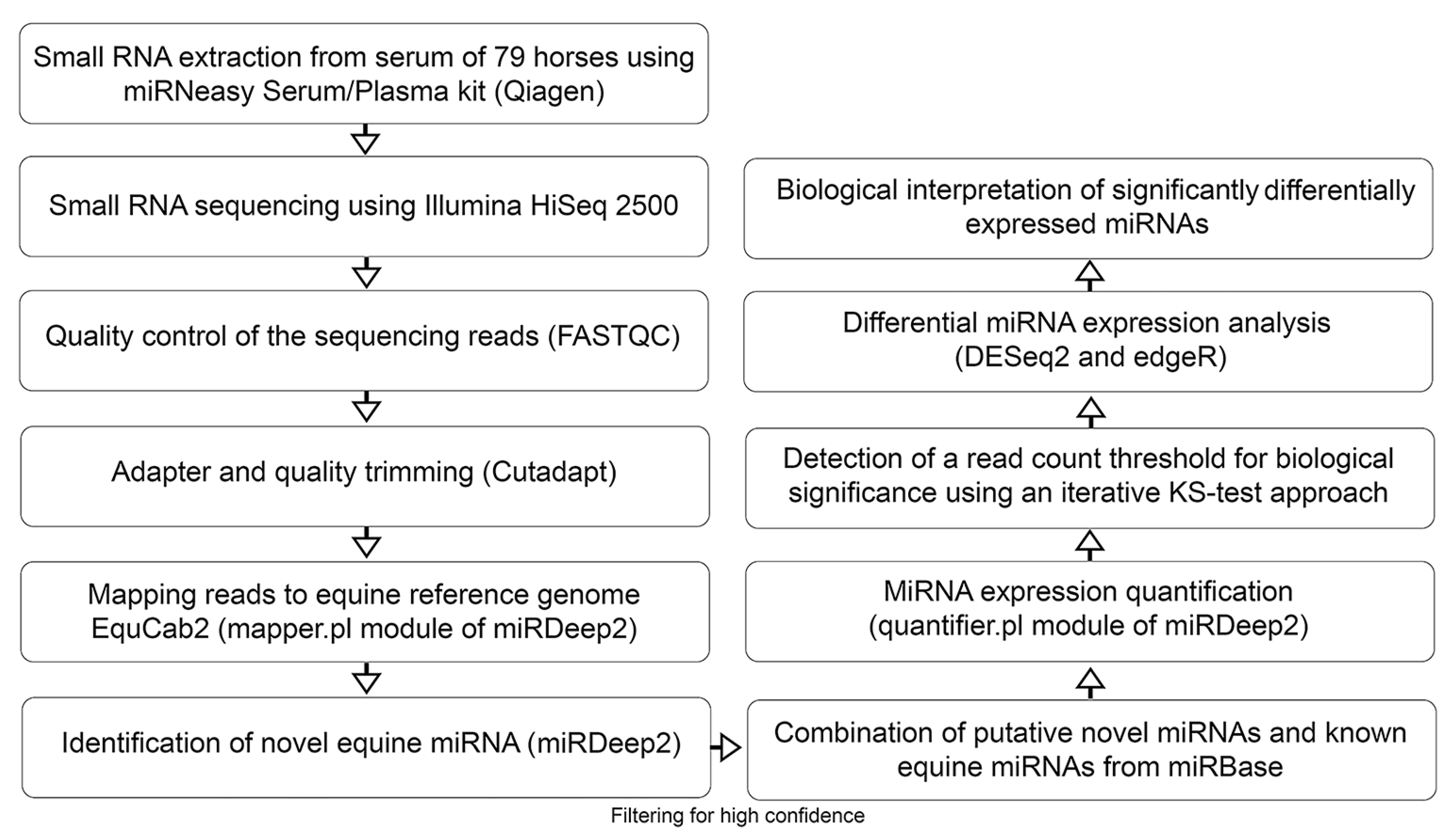
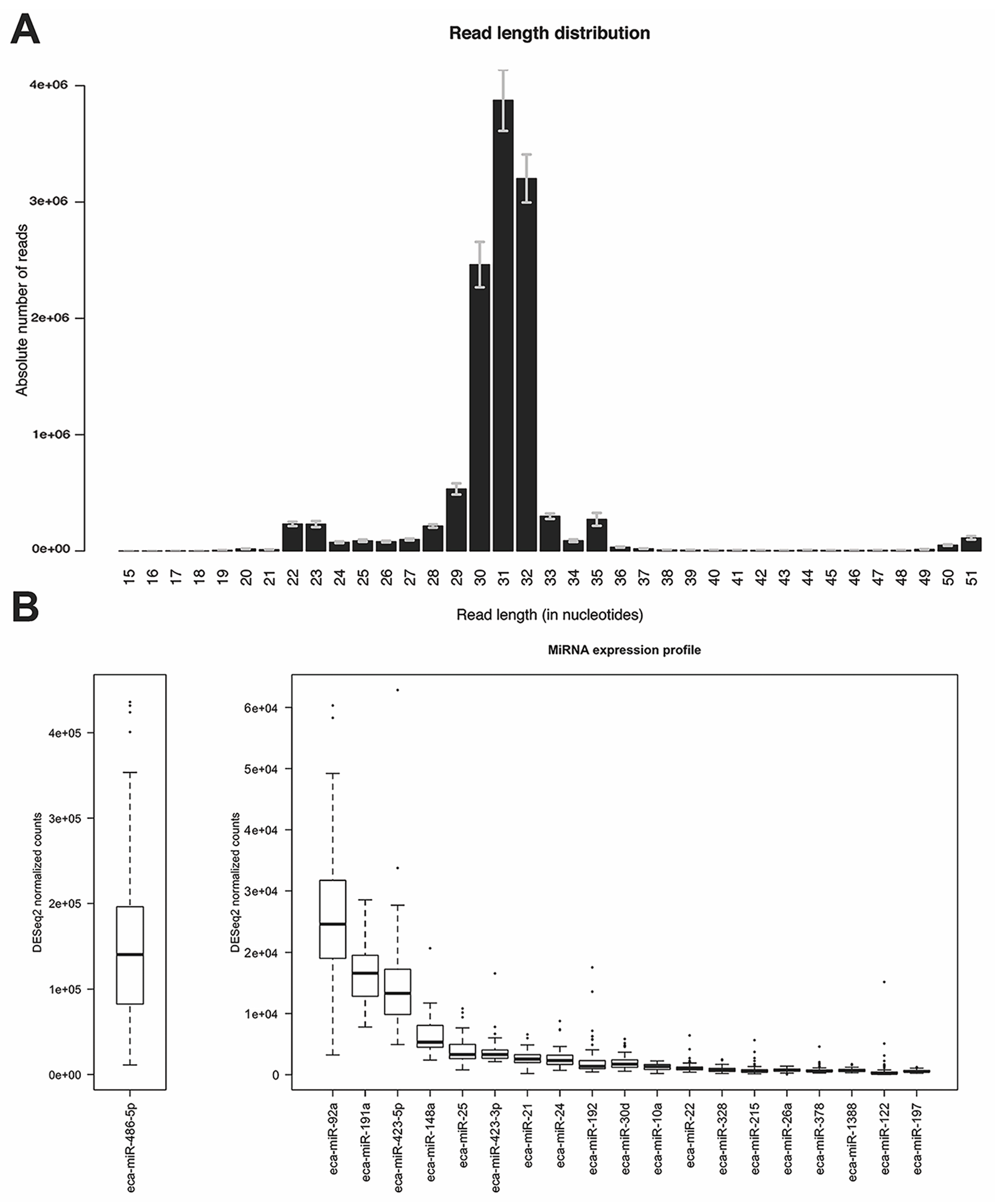
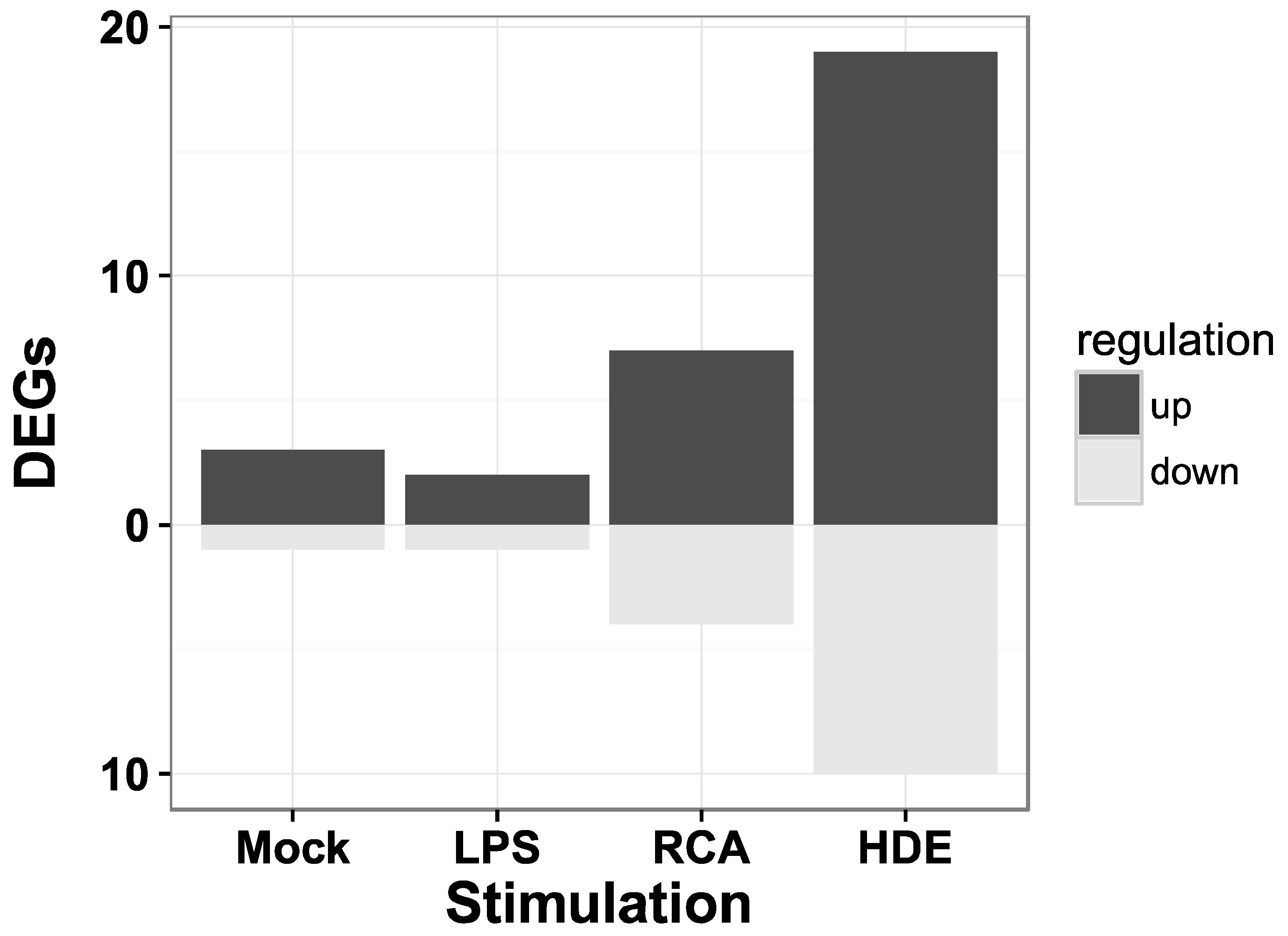
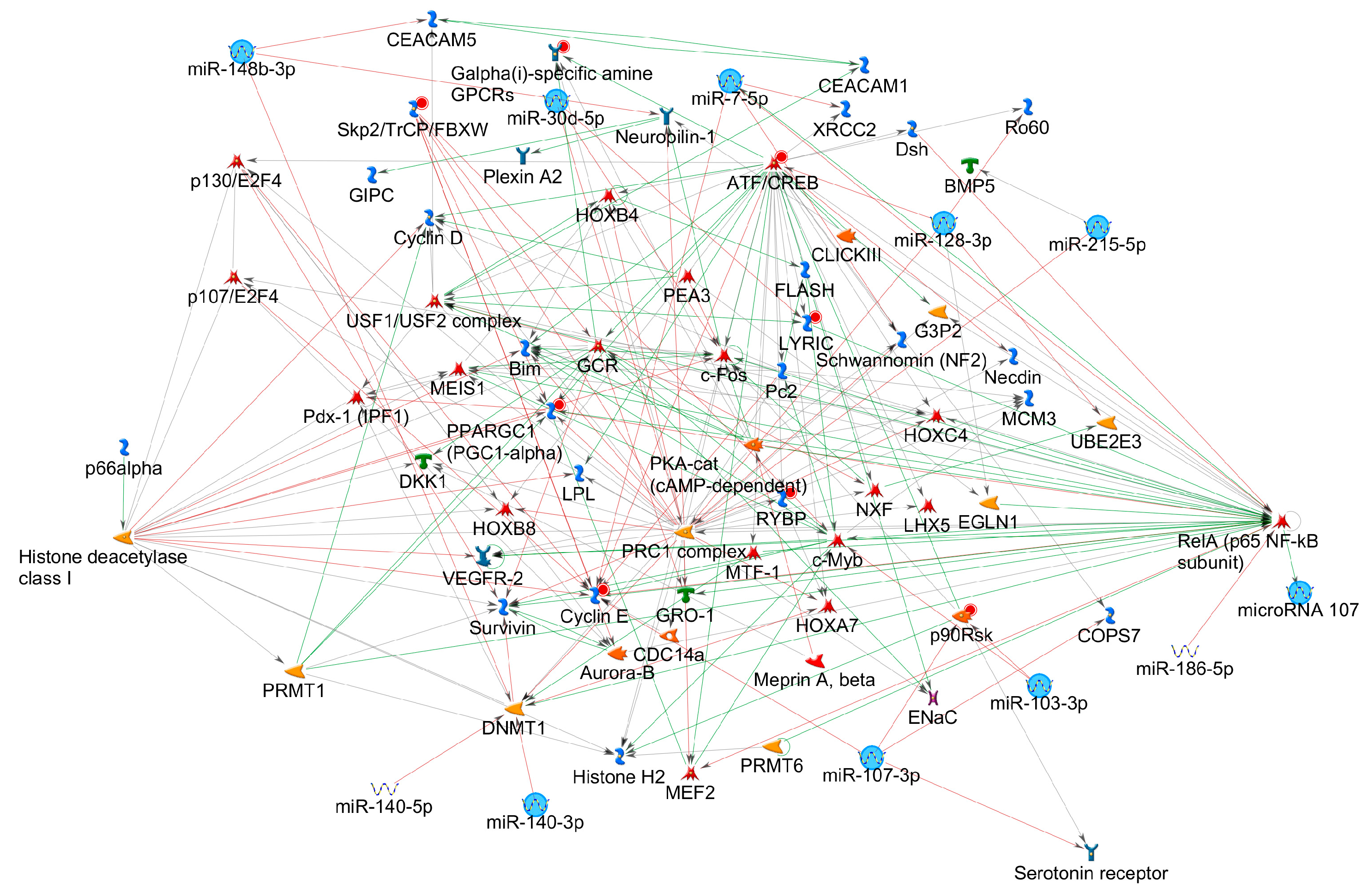
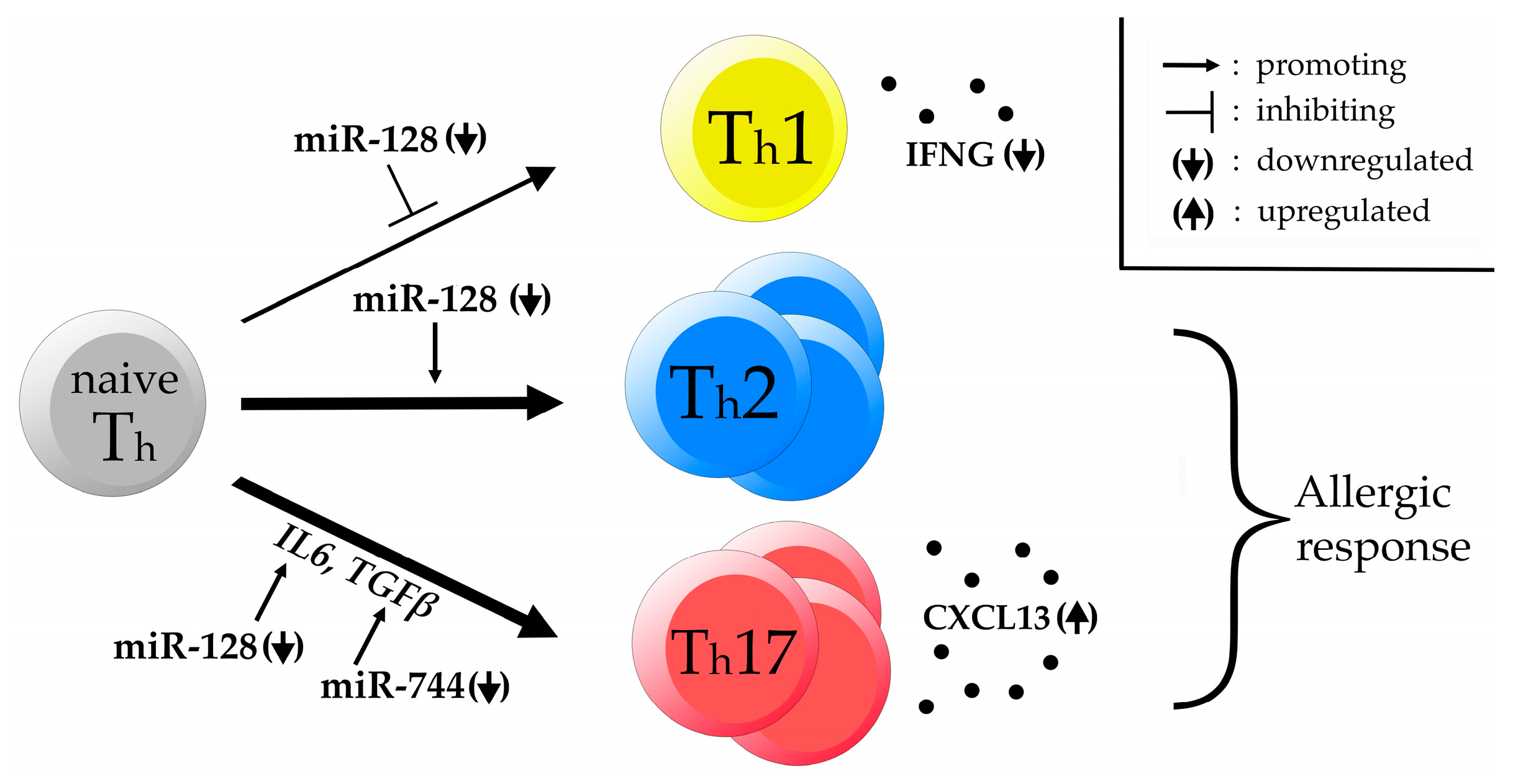
| Mature Equine miRNA | Human Mature miRNA Homologue | Mean (DESeq2 Normalized) Expression | Log2 Fold Change | Adjusted p (DESeq2) | Adjusted p (edgeR) |
|---|---|---|---|---|---|
| eca-miR-128 | hsa-miR-128-3p | 526 | −0.49 | 8.65 × 10−4 | 1.66 × 10−3 |
| eca-miR-744 | hsa-miR-744 | 168 | −0.27 | 0.028 | 0.044 |
| eca-miR-197 | hsa-miR-197 | 633 | −0.36 | 0.028 | 0.044 |
| eca-miR-103 | hsa-miR-103a-3p | 51 | 0.34 | 0.028 | 0.044 |
| eca-miR-107a | hsa-miR-107 | 51 | 0.34 | 0.028 | 0.044 |
| eca-miR-30d | hsa-miR-30d | 2073 | −0.41 | 0.028 | 0.044 |
| eca-miR-140-3p | hsa-miR-140-3p | 251 | 0.37 | 0.033 | 0.044 |
| eca-miR-7 | hsa-miR-7-5p | 70 | 0.47 | 0.035 | 0.06 |
| eca-miR-361-3p | hsa-miR-361-3p | 216 | −0.39 | 0.035 | 0.044 |
| eca-miR-148b-3p | hsa-miR-148b-3p | 103 | 0.29 | 0.043 | 0.084 |
| eca-miR-215 | hsa-miR-215 | 823 | 0.44 | 0.05 | 0.11 |
| Maps | Total Genes in Pathway | Target Genes | Adjusted p |
|---|---|---|---|
| Development: Regulation of epithelial-to-mesenchymal transition (EMT) | 64 | 11 | 1.024 × 10−4 |
| Development: phosphatidylinositol (3,4,5)-triphosphate (PIP3) signaling in cardiac myocytes | 47 | 9 | 2.703 × 10−4 |
| Translation: Regulation of eukaryotic initiation factor 2 (EIF2) activity | 39 | 8 | 4.293 × 10−4 |
| Neurophysiological process: Dynein-dynactin motor complex in axonal transport in neurons | 54 | 9 | 4.595 × 10−4 |
| Regulation of glycogen synthase kinase 3 beta (GSK3β) in bipolar disorder | 46 | 8 | 9.295 × 10−4 |
| Development: hepatocyte growth factor (HGF)-dependent inhibition of transforming growth factor beta(TGFB)-induced EMT | 34 | 7 | 9.295 × 10−4 |
| Cell cycle: Regulation of G1/S transition (part 1) | 38 | 7 | 1.730 × 10−3 |
| Translation: Insulin regulation of translation | 42 | 7 | 2.997 × 10−3 |
| Development: WNT signaling pathway. Part 1. Degradation of beta-catenin in the absence WNT signaling | 19 | 5 | 3.558 × 10−3 |
| Development: Thrombopoietin-regulated cell processes | 46 | 7 | 4.232 × 10−3 |
© 2017 by the authors. Licensee MDPI, Basel, Switzerland. This article is an open access article distributed under the terms and conditions of the Creative Commons Attribution (CC BY) license (http://creativecommons.org/licenses/by/4.0/).
Share and Cite
Pacholewska, A.; Kraft, M.F.; Gerber, V.; Jagannathan, V. Differential Expression of Serum MicroRNAs Supports CD4+ T Cell Differentiation into Th2/Th17 Cells in Severe Equine Asthma. Genes 2017, 8, 383. https://doi.org/10.3390/genes8120383
Pacholewska A, Kraft MF, Gerber V, Jagannathan V. Differential Expression of Serum MicroRNAs Supports CD4+ T Cell Differentiation into Th2/Th17 Cells in Severe Equine Asthma. Genes. 2017; 8(12):383. https://doi.org/10.3390/genes8120383
Chicago/Turabian StylePacholewska, Alicja, Matthias F. Kraft, Vincent Gerber, and Vidhya Jagannathan. 2017. "Differential Expression of Serum MicroRNAs Supports CD4+ T Cell Differentiation into Th2/Th17 Cells in Severe Equine Asthma" Genes 8, no. 12: 383. https://doi.org/10.3390/genes8120383
APA StylePacholewska, A., Kraft, M. F., Gerber, V., & Jagannathan, V. (2017). Differential Expression of Serum MicroRNAs Supports CD4+ T Cell Differentiation into Th2/Th17 Cells in Severe Equine Asthma. Genes, 8(12), 383. https://doi.org/10.3390/genes8120383






